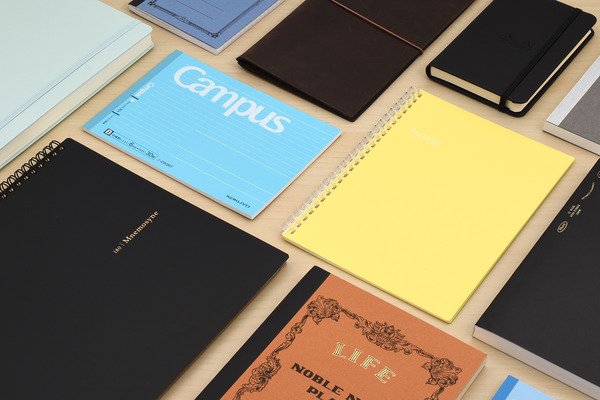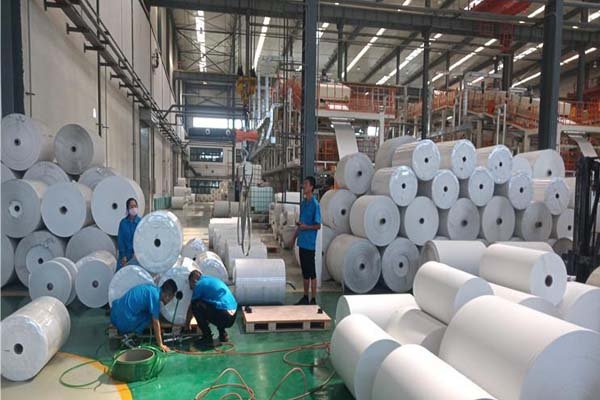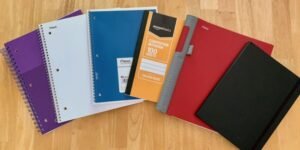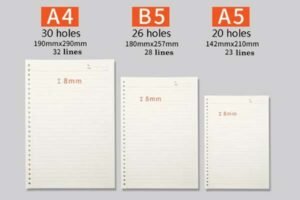
Are you feeling lost trying to figure out notebook paper sizes? It seems simple, but ordering the wrong size wastes time and money. Let me help clear things up based on my years in the notebook business.
Notebook paper doesn't have just one single size. The most common are US Letter (8.5 x 11 inches) in North America and A4 (210 x 297 mm) internationally. Many other standard sizes like A5 and B5 also exist.
The size you need really depends on where you are and what you'll use the notebook for. In the US and Canada, Letter size is king for standard documents and binders. But almost everywhere else, the ISO "A" series, especially A4, is the standard. This difference is important when you're ordering for international markets or need compatibility with specific systems.
Think about daily use. A large Letter or A4 notebook1 gives lots of space for notes in meetings or classes. Smaller sizes like A5 or B5 are easier to carry around. Understanding these basic differences is the first step to choosing the right notebook.
What Are the Standard Notebook Sizes?
So, let's look closer at the typical sizes you'll find most often. Knowing these standards makes ordering much easier.
Standard notebook sizes mainly follow the international ISO 216 standard2 (like A4, A5, A6, B5) or North American standards (Letter, Legal). A5 and B5 are very popular choices for portable everyday notebooks.

Let's dive deeper into these common standards.
ISO A Series (A4, A5, A6)
The ISO A series is clever. Each size is exactly half of the previous one. A4 is the big one, often used in printers and large notebooks. Cut it in half, you get A5, a very popular notebook size. Cut A5 in half, you get A6, great for pockets.
| Size | Dimensions (mm) | Dimensions (inches) | Common Uses |
|---|---|---|---|
| A4 | 210 x 297 mm | 8.3 x 11.7 inches | Desktop notebooks, binders, school notes |
| A5 | 148 x 210 mm | 5.8 x 8.3 inches | Journals, planners, portable notebooks |
| A6 | 105 x 148 mm | 4.1 x 5.8 inches | Pocket notebooks, small planners, notes |
This system is used worldwide, except mainly in North America. If you work with international clients or suppliers, knowing the A series is essential.
ISO B Series (B5)
The B series is like a cousin to the A series. B sizes are a bit larger than their corresponding A size number. For example, B5 is between A4 and A5. It's particularly popular in Japan and Korea for notebooks and planners.
| Size | Dimensions (mm) | Dimensions (inches) | Common Uses |
|---|---|---|---|
| B5 | 176 x 250 mm | 6.9 x 9.8 inches | Notebooks, journals (popular in Asia) |
B5 offers a good balance – more writing space than A5, but still more portable than A4 or Letter.
North American Sizes (Letter, Legal, Junior Legal)
In the US and Canada, things are different. Letter size is the standard for almost everything. Legal is longer, used for contracts. Junior Legal is like Letter cut in half, similar to A5 but slightly different dimensions.
| Size | Dimensions (inches) | Dimensions (mm) | Common Uses |
|---|---|---|---|
| Letter | 8.5 x 11 inches | 216 x 279 mm | Standard notebooks, binders, printing |
| Legal | 8.5 x 14 inches | 216 x 356 mm | Legal documents, some notepads |
| Junior Legal / Half Letter | 5.5 x 8.5 inches | 140 x 216 mm | Smaller notebooks, planners, compact binders |
If your main market is North America, these are the sizes you'll work with most.
Choosing the Right Standard Size
- Portability: A5, B5, A6, or Junior Legal are best if you carry your notebook often.
- Writing Space: Letter or A4 provide the most room.
- Region: Match the standard for your primary market (Letter for US/Canada, A-series elsewhere).
- Purpose: Meeting notes might need A4/Letter, while journaling could be A5/B5.
How Do Custom Notebook Sizes Work?
Sometimes, standard sizes just don't fit what you need. That's where custom sizes come in.
Custom notebook sizes mean we create notebooks matching your exact dimension requirements, different from standard A-series or Letter sizes. This allows unique branding or fitting specific needs like special planners or unique binders.

Let's explore why and how you might go custom.
Why Choose Custom Sizes?
There are several good reasons:
- Unique Branding: A non-standard size can make your product stand out.
- Specific Function: Maybe you need a notebook to fit perfectly in a specific bag, holder, or corporate gift box. We did this for a Silicon Valley tech company's onboarding kit.
- Compatibility: If you have proprietary binder rings or covers, you might need a custom paper size to match.
- Creative Projects: Artists or designers might want square notebooks, extra-wide formats for sketches, or very thin notebooks like a Japanese brand we worked with for a special planner.
- Special Use Cases: Think passport-sized travel journals or unique planner layouts.
The Customization Process
Creating a custom size involves a few steps:
- Define Needs: You tell us the exact dimensions (width x height). We also discuss paper type (like 80gsm, 100gsm, recycled, etc.), page count, binding (coil, sewn, binder mechanism), and cover design.
- Minimum Orders (MOQ): Custom work often requires minimum quantities because of setup involved. At NotebookRing®, we try to flexible. We can often do batch production starting at 500 units, and sometimes even support sample orders of 100 basic units.
- Sampling: We usually create a sample or prototype first. This lets you check the size, feel, and quality before full production. We offer free physical sample books with material swatches.
- Production: Once approved, we set up our machines for your specific size and produce your order. Our vertical integration helps control quality and timing here.
Common Custom Requests We Handle
- Passport sizes (around 88 x 125 mm / 3.5 x 4.9 inches)
- Square formats (e.g., 150 x 150 mm)
- Sizes compatible with specific planner systems (like Filofax variations)
- Extra thin or thick notebooks based on page count and paper type.
Does Paper Size Affect Notebook Cost?
It’s a practical question: how does choosing a specific size impact the price you pay?
Yes, paper size directly affects notebook cost. Larger sizes use more paper, increasing material costs. Custom sizes might also cost more due to specialized cutting, potential waste, and machine setup.

Let's break down the cost factors.
Factors Influencing Cost (Besides Size)
Size is just one piece of the puzzle. The final cost depends on many things:
- Paper Weight & Type: Heavier paper (like 100gsm vs 80gsm) costs more. Special papers like Tomoe River or European sketch paper also impact price. We offer upgrades like 80gsm to 100gsm for about +$0.07/book. Recycled paper is often available at no extra charge.
- Cover: Material (cardstock, PP, cloth) and complexity matter. Special processes like hot stamping ($0.08/unit), laser engraving ($0.12/unit), or embossing ($0.15/unit) add to the cost.
- Binding: Simple glue binding is often cheaper than durable sewn binding, metal coils (especially our patented seamless ones), or complex ring binder mechanisms (like adapting to Filofax 6-hole standards).
- Page Count: More pages mean more paper and potentially different binding needs.
- Printing: Custom inner page printing (grids, dots, logos, page numbers) adds cost compared to standard lined or blank pages.
- Order Quantity: This is a big one. Larger orders (like 10,000+ units) usually get a lower price per notebook than smaller orders (like 1,000 units). Our typical range is $0.84-$1.70 for 1k+ orders, dropping to $0.63-$1.30 for 10k+ orders on regular notebooks.
Cost Efficiency: Standard vs. Custom
- Standard Sizes (A4, Letter, A5, etc.): These are generally the most cost-effective. We have optimized processes, readily available materials, and less paper waste when cutting standard dimensions. Think economies of scale.
- Custom Sizes: These can be more expensive per unit, especially for smaller quantities. Why?
- Setup: Machines might need adjustments.
- Tooling: Sometimes new cutting dies are needed.
- Waste: Cutting non-standard shapes from standard paper rolls or sheets can create more unusable offcuts.
- However, the unique value or specific need might outweigh the higher cost. We work with clients to find the best balance.
Finding Your Perfect Notebook Partner: NotebookRing®
Choosing the right notebook size and specifications can feel complex. You need a partner who understands the options and can deliver exactly what you need, reliably and with high quality.
That's where we, NotebookRing®, come in. Since 2006, we've focused solely on manufacturing professional notebooks and binders. Our 15,000㎡ FSC-certified factory in Wenzhou, China, is equipped with 8 production lines, allowing us to handle both standard and highly customized orders.
Here’s how we can help you get the perfect notebooks:
- ✅ Full Size Expertise: We produce all standard sizes (A4, A5, A6, B5, Letter, etc.) and excel at creating custom dimensions tailored to your needs.
- ✅ Deep Customization: Beyond size, choose your paper (80-120gsm, recycled, specialty), inner page format (lines, grid, dot, blank), binding style (sewn, coil, binder mechanism), and cover finish (hot stamping, laser, emboss, cloth).
- ✅ Quality You Can Trust: With ISO 9001, FSC, and BSCI certifications, plus a rigorous 4-level quality control process, we ensure every notebook meets high standards, suitable for demanding markets in Europe, America, Japan, and Korea.
- ✅ Flexible Orders: We support batch production from 500 units and even sample orders from 100 units for basic versions, making us accessible for businesses of different sizes, like helping James Wong's gift company with monthly orders of 300 sets.
- ✅ Reliable Partnership: Our experience, like developing FSC-certified notebooks for a German chain bookstore (120,000+ units annually) or cost-effective custom sets for tech companies, shows we deliver.
- ✅ Global Logistics: We offer standard 30-day delivery and expedited options, handling EXW, FOB, or DDP terms.
If you need a reliable manufacturer who understands notebook sizes inside and out, let's talk.
Contact Timothy Wei at info@notebookring.com or visit www.notebookring.com. We offer free physical sample books and respond to inquiries within 24 hours.
Conclusion
So, there's no single answer to "what size is notebook paper?" It depends on standards like ISO (A4, A5) or US Letter, and your specific needs. Custom sizes are always possible. Remember size, paper, cover, and quantity all affect the final cost.





